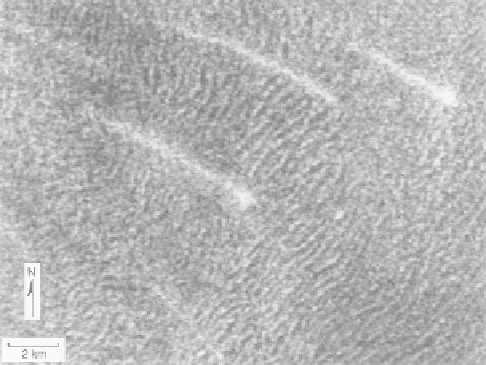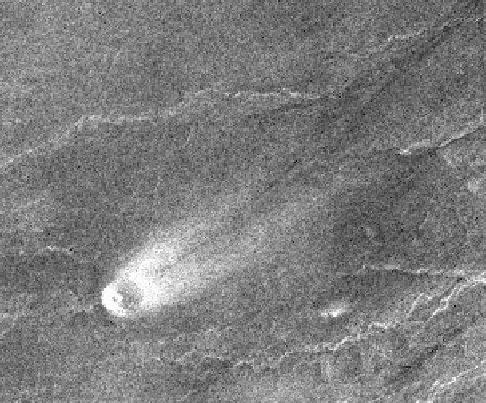Geology Reference
In-Depth Information
Aglaonice. Individual transverse dunes are several hundred
meters wide and have crests oriented generally north
-
south, while wind streaks within the
field suggest formative
winds from the east. The Fortuna
-
Meskhent dune
eld
was found in a valley between Ishtar Terra and Meskhent
Tessera and also has numerous wind streaks within the
eld
(Fig. 6.28)
. The formative wind patterns suggest
flow from the southeast to the northwest, with a shift toward
the west in the northern part of the
field. Although it is a
puzzle why more dunes were not found, experiments using
the NASAVenus Wind Tunnel show that, in the sluggish
winds on Venus, relatively small bedforms develop, includ-
ing so-called
“
micro-dunes
”
that are only centimeters in
size, which is far too small to be detected on the radar
images. They might, however, generate a rougher surface
than smooth plains, and it is possible that some of the radar-
bright plains could have sets of micro-dunes.
By far the most abundant aeolian features on Venus are
wind streaks, with more than 6,000 having been mapped
on Magellan images. These occur in a wide variety of
forms, with most being associated with topographic fea-
tures, such as small hills
(Fig. 6.29)
or ridges, and include
both radar-bright and radar-dark signatures
(Fig. 6.30)
.
Wind streaks are thought to result from the interaction of
surface winds with landforms, perhaps generating zones
of preferential erosion and deposition. For example, bright
streaks could form by the removal of
fine-grained clastic
Figure 6.28. Part of the Fortuna
field, showing sets
of transverse dunes and a few radar-bright streaks, indicating
prevailing winds from the southeast (lower right); the area shown is
about 55 km by 55 km (NASA Magellan MRPS 39824).
-
Meskhent dune
Figure 6.29. A radar-bright wind streak 26 km long formed in
association with a 5 km wide hill; wind was blowing from the lower
left toward the right at the time of streak formation (NASA
Magellan P-38810).
Figure 6.30. Radar-dark wind streaks associated with ridges; winds
were blowing from left to right at the time these features formed;
the area shown is 44 km by 64 km (NASA Magellan MRPS 3883).





